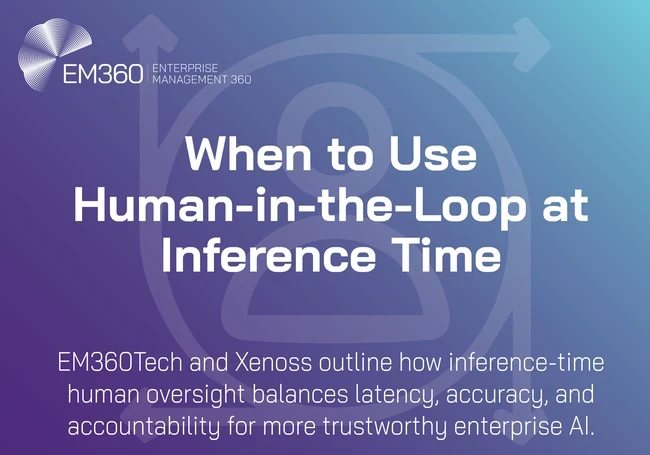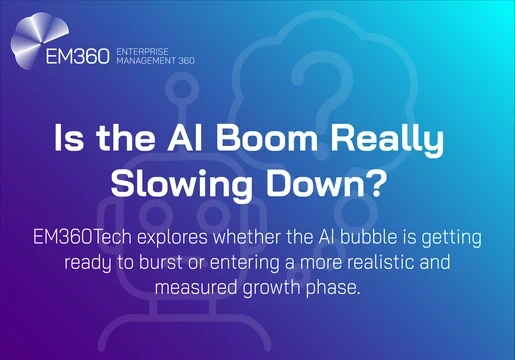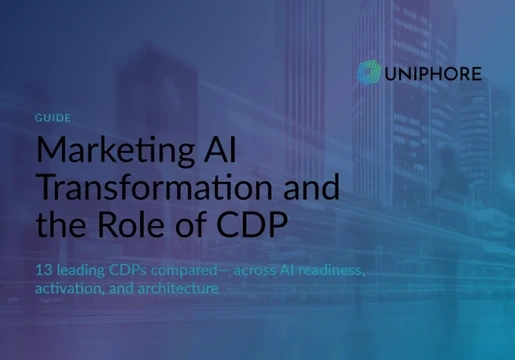AI delivers speed and scale, but high-stakes decisions still hinge on human judgement. The challenge is no longer whether to automate; it is where to place the human so outcomes stay safe, compliant, and explainable.
Many teams add people early through data labelling, evaluation, or human feedback during training, but the riskiest moments arrive later, when a live model output is about to trigger a payment hold, prioritise a patient, or alter a physical process. That is the moment that needs ownership, clear thresholds, and a record of what changed and why.
Put simply, trustworthy AI depends on inference-stage human oversight that is fast enough to keep pace and rigorous enough to stand up to audit. Which leads directly to the shift teams are making: from training-time quality control to decision-time assurance.

The Shift From Training Oversight to Decision-Time Assurance
Most HITL conversations centre on labelling, evaluation, and reinforcement learning from human feedback (RLHF). Those steps improve models before deployment. Inference-time oversight is different: it gives operators, clinicians, or analysts authority to review, override, or pause a decision as it happens, then logs what changed and why.
That distinction matters for governance. The EU AI Act's human-oversight requirements and the NIST AI Risk Management Framework both emphasise effective oversight during use, not only during development. Training-time quality is necessary; decision-time assurance maintains trustworthiness when systems face real-world complexity and edge cases that no training dataset can fully capture.
Why Inference-Stage Oversight Matters in High-Stakes AI
Inference is where risk concentrates. On one hand, false positives can cause payments to get blocked or leave clinicians overwhelmed. False negatives, on the other, can miss fraud, delay treatment, or trigger unsafe actions in cyber-physical systems.
Boards, regulators, and customers increasingly expect explainability, traceable human judgement, and clear accountability at the point of decision. That expectation reshapes operating models: teams must plan for who intervenes, when they intervene, and how the intervention is recorded — all without crippling throughput.
Use Case 1: Fraud Detection and Credit Scoring— Balancing Latency and Human Validation

Real-time payments and card authorisations run on tight latency budgets. It would be impossible to manually review every decision, but automation left to its own devices will probably lead to customer friction and also to heavy losses. Which means that the path forward is selective human intervention:
- Confidence-based interrupts: Route only uncertain or policy-sensitive transactions for human review based on confidence scores, anomaly flags, velocity rules, or merchant risk tiers.
- Tiered queues: Keep the authorisation flow fast for the majority, but queue specific transactions for near-real-time analysts when value, geography, device change, or synthetic-ID signals cross thresholds.
- Dual control for actions: Make it a requirement that a second human is needed for high-value reversals or manual approvals.
- Closed feedback loop: Every analyst decision updates feature stores and rules, tightening models over time.
This approach mirrors Xenoss work with international banking groups expanding into emerging markets.
For one NYC-headquartered bank entering the Indian market, HITL frameworks were implemented that balanced automated credit scoring with human oversight for edge cases where cultural and behavioral patterns differed from the training data.
The unified multi-modal approach achieved a 1.8-point Gini uplift using existing data sources, demonstrating how proper human oversight can enhance AI accuracy in unfamiliar market conditions.
Use Case 2: Clinical Triage — Human Judgment as a Safety Circuit

Clinical AI should inform decisions, not make them. Safety and regulation demand that competent clinicians remain in control. The practical pattern is AI suggests, and a human confirms:
- Escalation on uncertainty: When a model’s confidence drops or inputs fall outside the training distribution, the system escalates to a clinician with clearly labelled findings and rationale.
- Structured overrides: The interface supports rapid accept, modify, or reject with mandatory reason codes that feed audit logs.
- Alarm hygiene: Carefully tune thresholds to help reduce and prevent alert fatigue, while also making sure that actual deterioration signals always reach a human as quickly as possible.
- Usability and labelling: Clear intended-use statements, limitations, and contraindications prevent over-reliance and support safe workflows.
In pharmaceutical environments like clinical trials, HITL systems ensure that AI-flagged adverse events receive mandatory human review within regulatory timeframes.
The hybrid approach combines pattern detection across thousands of patients with clinical expertise that no algorithm can replace, particularly for rare events or drug interactions outside standard protocols.
The result is faster triage where appropriate, with documented human judgement on every critical escalation.
Use Case 3: IoT Safety and Autonomous Operations — When Machines Need a Human Pause

In industrial and city infrastructure, automated actions can affect physical safety. The right approach is operator-centred control:
- Operator acknowledgement loops: For unusual sensor patterns or policy-sensitive actions (e.g., shutting a valve, isolating a feeder), the system pauses and requests human acknowledgement before proceeding.
- Safe-state fallbacks: If an approval or acknowledgement doesn’t arrive within the time allowed for either, actions should automatically fall back to a predefined safe state.
- Event traceability: Post-incident review must always be simple and undeniable, so make sure that every anomaly, escalation, override, and outcome is time-stamped, signed, and immutable.
- Progressive autonomy: Build your system so that human decisions on edge cases become training material over time, which improves detection and reduces unnecessary interrupts in the long run.
This preserves responsiveness without sacrificing operational safety and accountability.
Design Patterns for Decision-Time Human-in-the-Loop
You do not need a heavy governance programme to start. You need three patterns that fit neatly into existing pipelines.
The challenge with LLMs in enterprise environments extends far beyond simple hallucinations. We observe LLM outcome degradation across multiple dimensions: reasoning drift, suboptimal logic patterns, and subtle accuracy erosion. These are the issues that are often harder to detect than outright fabrications, but just as damaging in high-stakes settings.
There’s no silver bullet. One effective approach is a dual-LLM system, where a generalist model is paired with a domain-specific expert LLM to ensure outputs meet rigorous industry standards and compliance requirements. Another critical layer is semantic validation: from domain knowledge graphs to deterministic rule engines that verify LLM outcomes.
But we can’t and shouldn’t remove humans entirely.
Our decade of enterprise AI deployment has shown that the key lies in balancing automation with human oversight so teams remain focused on high-impact decisions.
Dmitry Sverdlik, CEO, Xenoss
Interrupts
Define uncertainty, harm, or policy thresholds that automatically trigger a human checkpoint. Uncertainty can be model-reported, ensemble-derived, or inferred from data drift, out-of-distribution signals, rule hits, or ethics flags.
Keep the interface simple: present the inputs, model output, the reason for pausing, and the available actions. Aim for one-click decisions with structured reasons.
Fallbacks
If human attention breaches the latency budget, degrade gracefully. Options include temporary allow, temporary deny, hold-and-review, safe-state, or deterministic business rules. Choose per risk tier. Crucially, the action and rationale should be visible to downstream systems and revisited as part of continuous improvement.
Logging
Treat human oversight as first-class telemetry. Make sure your logging system is capturing info about who intervened, what changed, and why it changed. Also, make sure that details like input snapshots, model version, feature hashes, and environmental context are included in log files.
Good logs unlock post-hoc explainability, satisfy audits, and feed training pipelines with high-value edge cases.

Latency, Accuracy, and Accountability — Finding the Right Balance
Most teams struggle here. Speed wins customers; accuracy and accountability keep your licence to operate. The trade-offs can be shaped, not endured.
- Risk-tiered decisioning: Map decision types to risk levels. Low-risk paths avoid human checkpoints; medium-risk paths use asynchronous review; high-risk paths demand synchronous oversight or safe-state fallbacks.
- Confidence economics: Calculate or determine confidence bands and pair them with an analysis of business impacts to set review thresholds. This helps make sure you’re shifting outcomes meaningfully. And remember, always — don’t review what you can’t change.
- Smart sampling: Rather than reviewing every borderline case, sample decisions to keep humans focused on high-leverage insights while maintaining statistical coverage.
- Throughput-aware design: Reserve synchronous human review for narrow slices, and architect the rest as near-real-time queues with strict service-level objectives.
- Human factors: Optimise the interface for signal-to-noise, with clear rationales, sorted queues, and reason codes. Humans are your most valuable and most limited resource.
The goal is a system where humans intervene precisely where they add the most value, and every intervention strengthens the next decision.
Best-Practice Checklist for Inference-Time HITL

- Set quantified thresholds – tie uncertainty and policy triggers to business impact and safety risk, and make them measurable, reviewable, and owned
- Assign accountable reviewers – define on-call rotas, permissions, training, and clear authority to override
- Design for speed and clarity – one screen, concise context, single-click actions, and structured reason codes
- Log like an auditor – capture inputs, outputs, model version, feature snapshot, who acted, when, and why
- Protect latency budgets – reserve synchronous review for high-risk cases, and use safe fallbacks or asynchronous queues with firm SLAs elsewhere
- Feed decisions back – turn human corrections into updated features, thresholds, rules, and training data
- Make oversight visible – state intended use, limitations, escalation paths, and who is in control at decision time
- Drill the edge cases – rehearse failures, hand-offs, and comms, and track time-to-intervention to fix bottlenecks fast
Final Thoughts: Oversight Turns Automation Into Trust
Trustworthy AI doesn’t emerge from scale; it comes from design. Putting human judgement where it matters most — in the live loop of decisions — makes automation accountable, explainable, and auditable without slowing it down.
Inference-stage HITL closes the last gap between performance and responsibility, giving enterprises a framework that satisfies both regulators and reality. The payoff is sharper accuracy, faster recovery, and systems that stand up to scrutiny when it counts.
That balance of governance and performance is exactly what the EM360Tech community explores every day — how leaders operationalise trust without trading off innovation. It’s also what companies like Xenoss enable in practice, building the high-throughput data pipelines and event-driven architectures that make human oversight viable at production speed.
Together, they point to the same truth: the future of AI isn’t human or machine — it’s how well the two learn to think together.







Comments ( 0 )